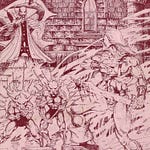White Dwarf Issue #3, published Oct/Nov 1977, encapsulates the British gaming scene’s creative ferment and DIY ethos. It blends practical artistic guidance, community-driven discourse, and gameplay mechanics, reflecting both the ambitions of its editors and the evolving identity of RPGs as a medium.
The introduction by Ian Livingstone positions White Dwarf as a pioneering platform for British gamers, addressing scepticism about the viability of a UK-centric publication in a market dominated by American titles like D&D. Livingstone’s editorial strikes a balance between informative journalism and participatory culture, urging readers to shape the magazine’s future through contributions and feedback. This democratic ethos mirrors the collaborative spirit of early RPG communities, where rules were fluid and player creativity paramount. His rejection of complacency, emphasising innovation over “safe, stereotyped formats,” sets the tone for the issue’s eclectic content, from solo dungeon mapping to miniature painting guides.
Roger Moores’ Solo Dungeon Mapping article introduces a system for generating dungeons using dice rolls, graph paper, and modular maps. Moores emphasises player agency and procedural generation by dividing maps into 200’x200’ sections with randomised entry points. The system’s map what you see philosophy, vision limits (e.g. torchlight at 40’), and environmental hazards create an immersive, refereeless experience. However, the reliance on randomisation risks disjointed narratives, requiring players to fill gaps imaginatively, a trade-off between creativity and structure that foreshadows modern procedural RPG design. Moores’ inclusion of anomalies like looping corridors and secret doors, resolved through probability tables, underscores the tension between algorithmic rigour and emergent storytelling.
Don Turnbull returns for another bash at trying to explain the Monstermark System. While it admittedly revolutionised monster difficulty assessment, calculating a composite score (M) from defensive and offensive factors seemed like an overcomplication. The formula M=(D+A)2M = \frac{(D + A)}{2}M=2(D+A), where DDD (armour class, hit dice) and AAA (damage output, special abilities) derive from statistical analysis, introduces a quantitative framework for experience point allocation. Turnbull’s iterative revisions, such as correcting Owlbear calculations, highlight the system’s adaptability. Yet, reducing monsters to numerical values risks privileging combat efficiency over narrative roleplay, a critique emblematic of broader debates about mechanisation in RPG design. The system’s influence is undeniable, prefiguring later efforts to balance gameplay through mathematical rigour.
Eddie Jones’ guide elevates miniature painting from a hobbyist craft to an art form. His technical advice on materials, contrasting oil-based (ALKYD) and water-based (Cryla) paints, emphasises durability and versatility, while his emphasis on brush care, layering, and shading reflects a commitment to realism. Jones treats miniatures as narrative artefacts, urging painters to align colour choices with character lore (e.g. earthy tones for Conan’s musculature). However, his focus on technical mastery assumes a dedicated audience, potentially alienating casual players, which would not be out of place in today’s magazine. This duality mirrors RPGs’ identity as creative outlets and games, bridging aesthetic and utilitarian goals.
Fred Hemmings’ Competitive D&D campaign design emphasises tactical challenge over narrative cohesion, featuring poetic riddles and high-stakes combat scenarios such as Room 51’s “machine of heart’s desire,” which pits players against dynamically scaled foes based on their chosen rewards. While innovative in its mechanical rigour, the module's adversarial tone, evident in directives like “reducing the party by half their hits,” risks overshadowing collaborative storytelling in favour of punitive difficulty. Meanwhile, the magazine’s critical authority is showcased in its Open Box reviews, where titles like Citadel and Battle of the Five Armies are dissected using a pioneering 1-10 scoring system and a “Good/Bad Points” template, setting foundational standards for game criticism. This ethos of community dialogue extends to the Letters section, where reader debates over the Monstermark system’s mathematical complexity and divergent dungeon design philosophies highlight the participatory culture of early RPG fandom, a precursor to the structured yet open discourse of modern online forums.
White Dwarf Issue #3 captures the nascent RPG culture’s tension between creative freedom and systemic rigour. While its procedural dungeon generation and quantitative monster balancing reflect a push for structure, articles like Jones’ painting guide and Livingstone’s editorial underscore the human element, artistry, collaboration, and improvisation. The magazine’s focus on difficulty and mechanics occasionally side lines narrative depth, a critique that resonates in contemporary indie RPGs’ emphasis on storytelling. As a historical artefact, the issue exemplifies the 1970s gaming scene’s experimental spirit, where rules were mutable and creativity paramount. Its legacy endures in modern indie RPGs and procedural generation tools, proving that the DIY ethos of White Dwarf remains a cornerstone of the genre.












Share this post